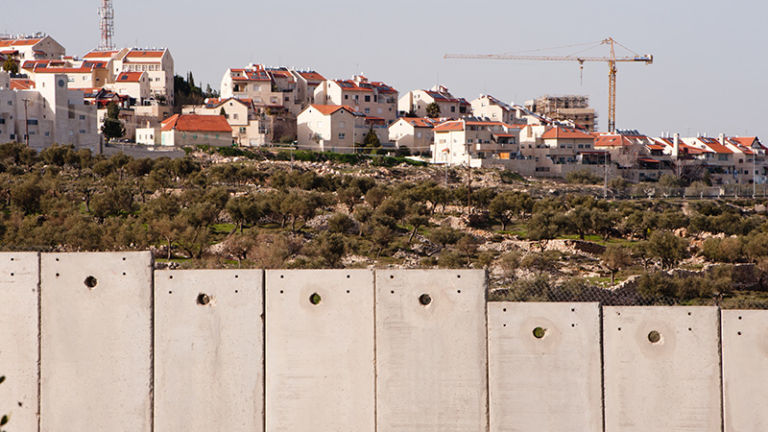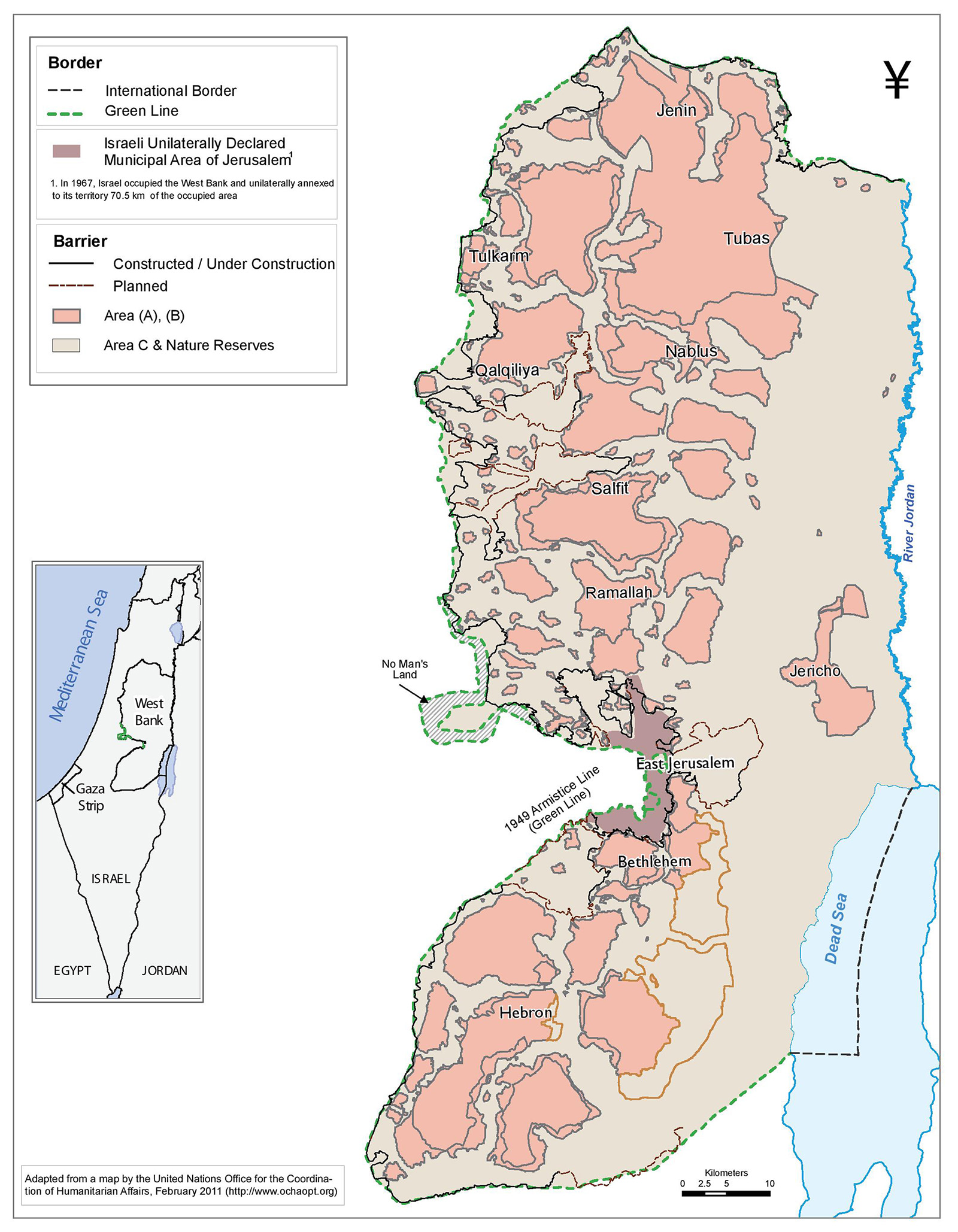
Attacks by Israeli settlers on Palestinians and their property in Area C of the occupied West Bank have increased in scope and geographic reach. Developments in the area have become focal points in ongoing daily events in Palestine today. Area C seems to be the latest front line in Israel’s march to shrink Palestinian territory and spread its full power and authority over all the occupied Palestinian territories.
How Did Area C Come into Being?
The Cairo Interim Agreement of 1994 between Israel and the Palestine Liberation Organization included a detailed plan for a gradual transfer of power and civilian functions from the Israeli military government and its Civil Administration, which governed the West Bank and Gaza since 1967, to the newly created Palestinian National Authority (PNA, or PA). The process was intended deliberately to be gradual and to lead ultimately to a Palestinian state. Serious unresolved issues such as the status of Jerusalem, the settlements, refugees, borders, security arrangements, and relations were designated as “final status” issues. They were to be settled in negotiations that would start within three years, and which were to be concluded no later than five years from the date of signing the accord and the creation of the PA on May 4, 1994.
The plan included the designation of the most densely populated cities of the West Bank—Nablus, Jenin, Tulkarm, Qalqiliya, Ramallah, Bethlehem, Jericho, and most of Hebron—as Area A (about 18 percent of the West Bank), to be under full Palestinian control—subject, of course, to the agreement itself—and Area B (about 21 percent), primarily the centers of populated villages in the West Bank, which would be governed by the PA in civilian matters but where Israel would have security authority. Areas designated as C (about 60 percent of the West Bank) would contain all Jewish settlements, army bases, and everything else in between, which would continue under the then-current rule of the Israeli army and its Civil Administration. The following map reflects the different areas as they appeared in 2011.
Source: Palestinian Academic Society for the Study of International Affairs (PASSIA)
The process included a gradual transfer of additional territories, which would be redesignated from Area C to B and from Area B to A, continuously expanding the territories under direct PA control and culminating in a state, no later than in five years, as the final status issues are negotiated and resolved.
Two additional territorial transfers occurred, expanding the territory under PA rule. A third was changed as Israel designated much of the territory it was going to transfer as “nature reserves” so that they would not be added to Areas A and B as was originally planned. Perhaps the intention was to prevent the Palestinians from building any structures there, as Israel was becoming more and more reluctant to expand the areas under PA control. The PA had the authority under the agreement to issue building and construction permits to Palestinians in those areas.
Israel Does Away with Oslo
As negotiations bogged down after the signing of the Oslo Accords, transfers slowed and then stopped altogether. With the assassination of Prime Minister Yitzhak Rabin in 1995 and the accession to power of the Likud Party under Ariel Sharon and Benjamin Netanyahu, the entire process was halted. Many in the new government were opposed to the Oslo process altogether and felt no compulsion to continue with it or to abide by its terms; it is noteworthy that while they continued to demand that Palestinians scrupulously observe its terms, they felt no need to do so themselves. After the Second Intifada (2000-2005), for example, they cut off the Gaza Strip from the West Bank and removed the “safe passage” requirements of Oslo, which specified that Gaza and the West Bank were to be treated as a single territory. They also felt free to invade Areas A and B and to routinely carry out arrests and extrajudicial killings there, as well as to withhold, from time to time, monies they were obligated to transfer to the PA, as a form of control and pressure.
Israel refused to follow the timetable provided in the Oslo Accords and started treating the situation on the ground as a permanent one.
Israel also refused to follow the timetable provided in the Oslo Accords and started treating the situation on the ground as a permanent one. To Rabin and his successors, it seemed that the dates set in the agreement were aspirational and not binding. Over 20 years have passed since the lapse of the last deadline, so it is worthwhile to examine the current situation as one that Israel believes or hopes to be a permanent one.
Today’s Conditions in Area C
Israel now considers Area C as totally and permanently within its full control. Settlers have always treated Area C as theirs and have resisted any attempt by Palestinians to develop, build up, or even normally use their private property within that area. A good example is what happened with the new Palestinian town of Rawabi, north of Ramallah. The $1 billion construction project had to wait for a long time to secure water supplies because of the objections by Silvan Shalom, then-minister of National Infrastructures, Energy, and Water Resources, who was under pressure from groups of settlers objecting to the building of the town. Finally, then-Prime Minister Benjamin Netanyahu had to intervene personally and allow the water supplies to flow, ahead of his 2015 visit to the United States. Settler groups have in effect set themselves up as vigilantes to spot, report, and prevent any Palestinian activity that they consider to be trespass and encroachment on what they deem as state land. For a while now, they demand that the army stop the activity; if it does not, they themselves use force to harass Palestinians or drive them away.
Settler groups have in effect set themselves up as vigilantes to spot, report, and prevent any Palestinian activity that they consider to be trespass and encroachment on what they deem as state land.
A look at the map of the West Bank shows precisely how Area C is currently constituted. The Israeli settlements within the area are administratively organized into regional blocks. About 400,000 Israeli Jewish settlers live there and view its entirety as a reserve for their growth. Actual areas of planning control are continuously expanding, while Palestinians still living in Area C are having a harder time accessing their properties. An estimated 300,000 Palestinians also live in residential areas located partially or wholly in Area C. It is to be noted that the entire Area C forms a contiguous territory seamlessly connected to Israel, in which Israeli settlers and vehicles can move back and forth, while Palestinian residents are prevented by physical obstacles and checkpoints from moving into Israel, or even between Area C and Areas A and B. Areas A and B are notoriously noncontiguous, and police officers of the PA need specific permission and coordination with the Israelis to move between the different islands of Areas A and B in carrying out their duties.
Officially, the legal status of Area C is governed by Jordanian law that has been amended by Israeli military orders. Many of these incorporate aspects of Israeli law as well as set up the structures for the settlement blocks. The Civil Administration supposedly continues the functions of the Jordanian ministries of health, education, services, and the like, but most of these functions have been transferred to the PA in areas A and B. For all intents and purposes, the Israeli Jewish residents of Area C are treated as if they live in Israel. Palestinians in Area C generally have to rely on services in Areas A and B that include schools and clinics.
Practically, no licenses are issued by the Civil Administration for building even rudimentary structures and walls in Area C, and planting trees of any kind is also prohibited. The planting of grains and vegetables is permitted, but further restrictions of access to these areas is continuing, whether through designation of large areas as “firing zones” or “training zones” by the army, and by denial and destruction of water sources and roads in that area. Finally, and when all else fails, outright attacks and intimidation by settlers are used to force people off the land and move them toward Areas A and B. This is a continuing feature of life in Area C. In addition, solar panels and other structures, often built with EU funding, have been regularly destroyed or confiscated by the Israeli army.
Outright attacks and intimidation by settlers are used to force people off the land and move them toward Areas A and B.
Existing trees, such as olive trees, also become a source of tension, as Israelis try to restrict Palestinian access to them year-round; at harvest time, it becomes a struggle to reach the trees to harvest the olives, which are sometimes stolen or cut down. Palestinian farmers are regularly attacked as they attempt to harvest them. This phenomenon has become a common source of friction and tension as foreign and Israeli peace activists often accompany Palestinian farmers and help in the harvest.
The Future of Area C
Under the Trump Administration, and in the first few months of the Naftali Bennett Administration, there was talk of ending the charade and outright annexing the entire Area C to Israel. There was an international outcry against such an action. For their part, Israeli officials were convinced that there was no need for formal de jure annexation since they could act fully as a sovereign without formal annexation. In fact, the absence of formal annexation removes the need to provide any rights or services under Israeli law to the hundreds of thousands of Palestinians still living in Area C.
The absence of formal annexation removes the need to provide any rights or services under Israeli law to the hundreds of thousands of Palestinians still living in Area C.
However, as the Israeli government temporarily abandoned formal annexation, Israeli settlers increased the daily harassment of Palestinians in an effort to drive them away and into the Palestinian enclaves of Areas A and B, while the PA was given tacit authorization to provide services to the Palestinians in Area C. For example, while the Israeli Civil Administration continued to issue military orders concerning COVID-19, it had no plans to distribute vaccines to Palestinians in Area C and left that task to the PA, even though the latter has no formal authority or responsibilities there. Further, PA officials were formally barred from even entering the region without permission and coordination with the Israeli army and the Civil Administration.
What is happening in Area C is a clear indication that the final nails are being driven into the coffin of the two-state solution. If a Palestinian state is ever to exit in the West Bank, conditions on the ground today prove that it is unlikely to incorporate this largest part of the occupied territory. Indeed, it is not difficult to believe that effective annexation and incorporation of Area C into Israel has been largely completed, and fully under the eyes of the international community.


